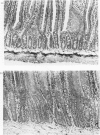Abstract
When symmetrical 1,2 dimethylhydrazine was administered to rats by weekly s.c. injection, 37% of the animals had developed small intestinal carcinomas after 21-27 weeks. These lesions were largely localized to duodenum and upper jejunum. At the same time there was a diffuse crypt hyperplasia in the jejunum which affected all the treated animals, not just those with neoplasms. This marked hyperplasia was preceded by a modest sustained crypt elongation which was seen soon after DMH injections began. In these hyperplastic jejunal crypts the absolute size of the proliferative compartment was increased, but the growth fraction calculated from labelling studies appeared to fall, probably by reduction in relative size of the proliferating population within the proliferative compartment. No convincing alteration in actual cell-cycle time was observed in the abnormal crypts. There was a slight (25%) increase in cell-production rate in the abnormal crypts.
Full text
PDF
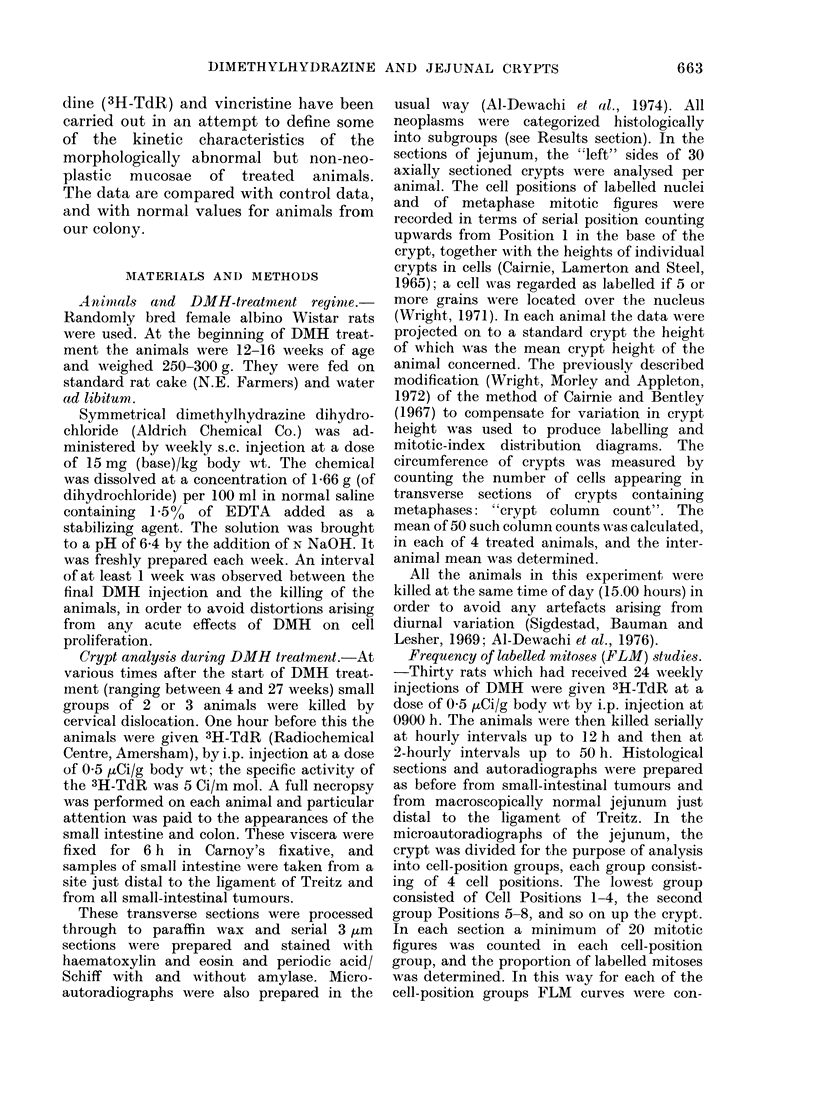


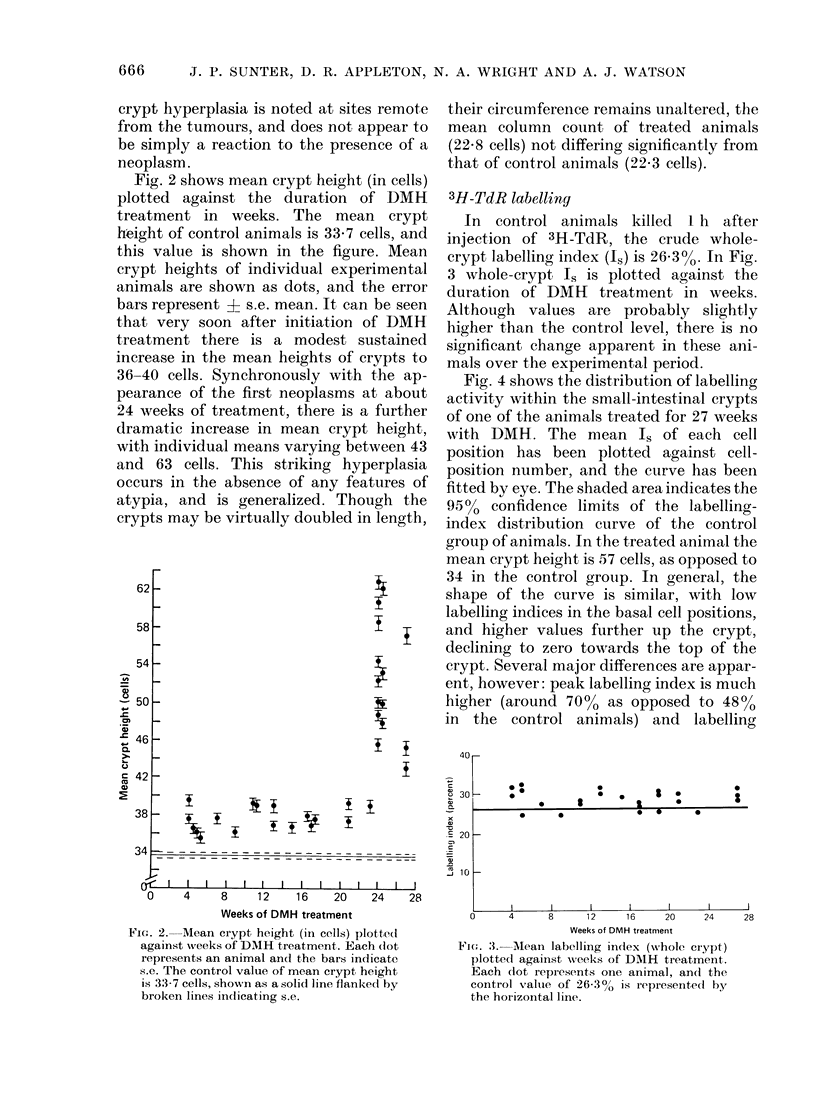


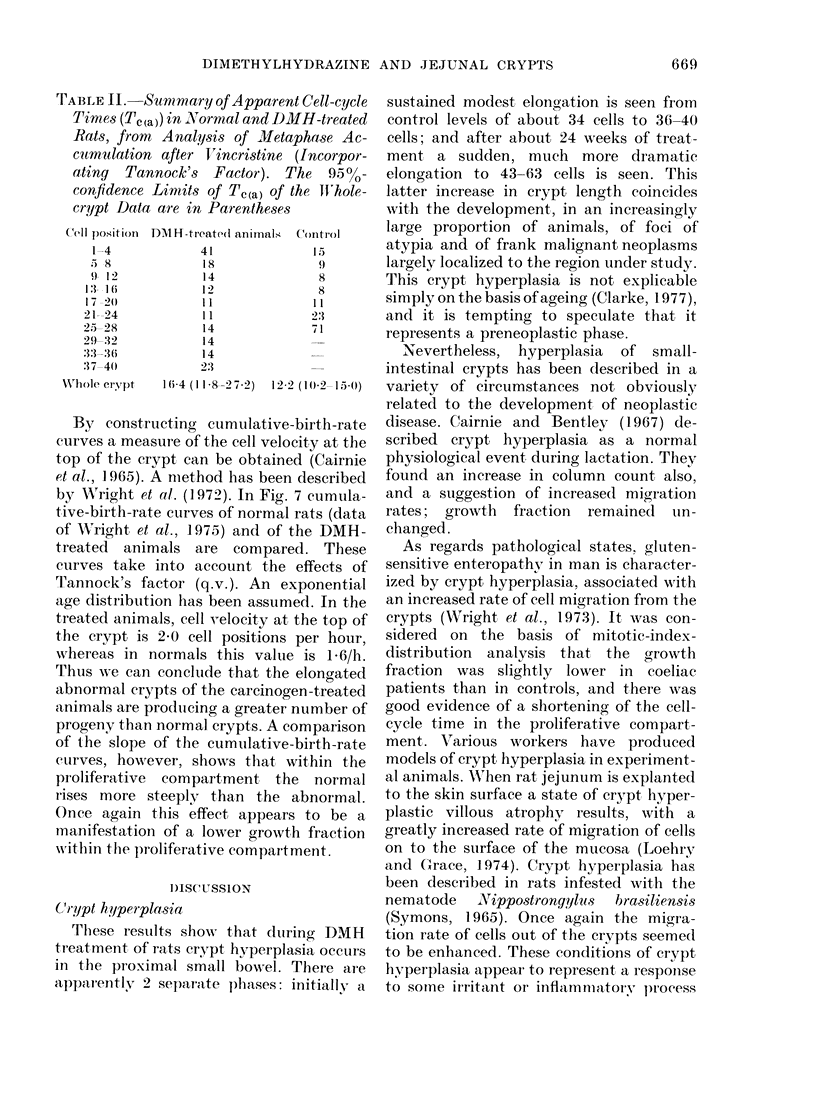
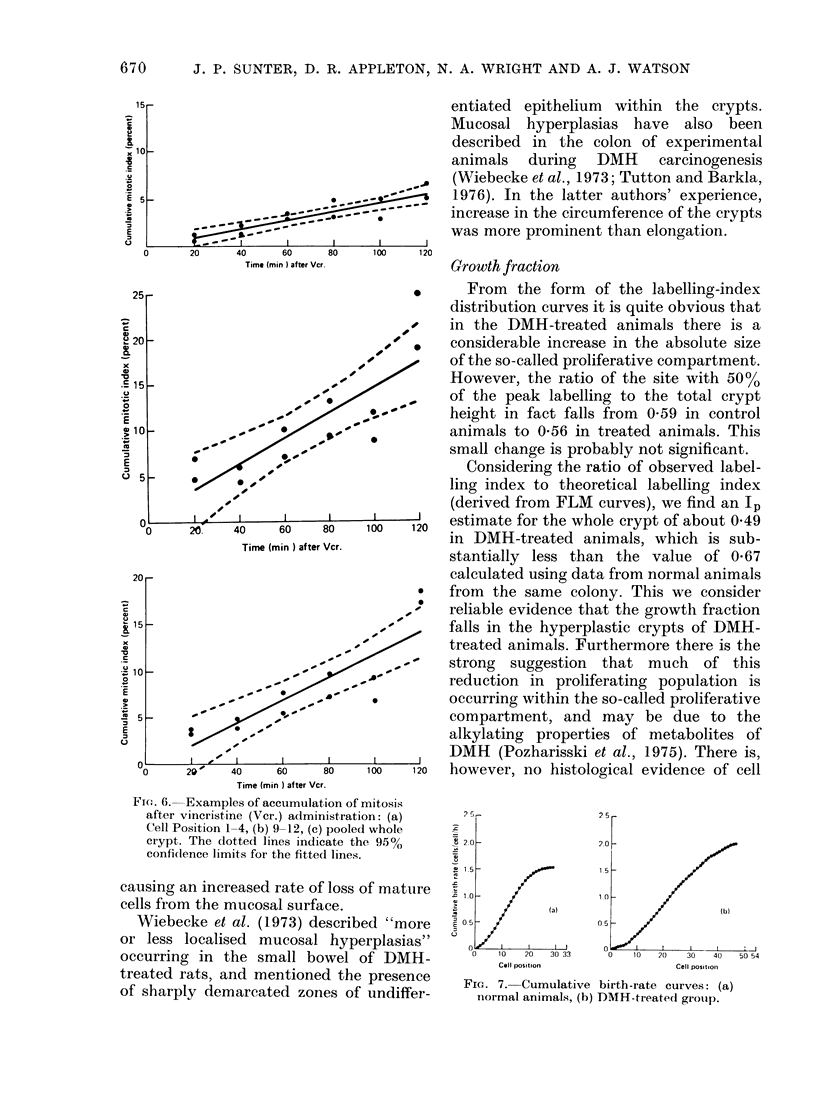
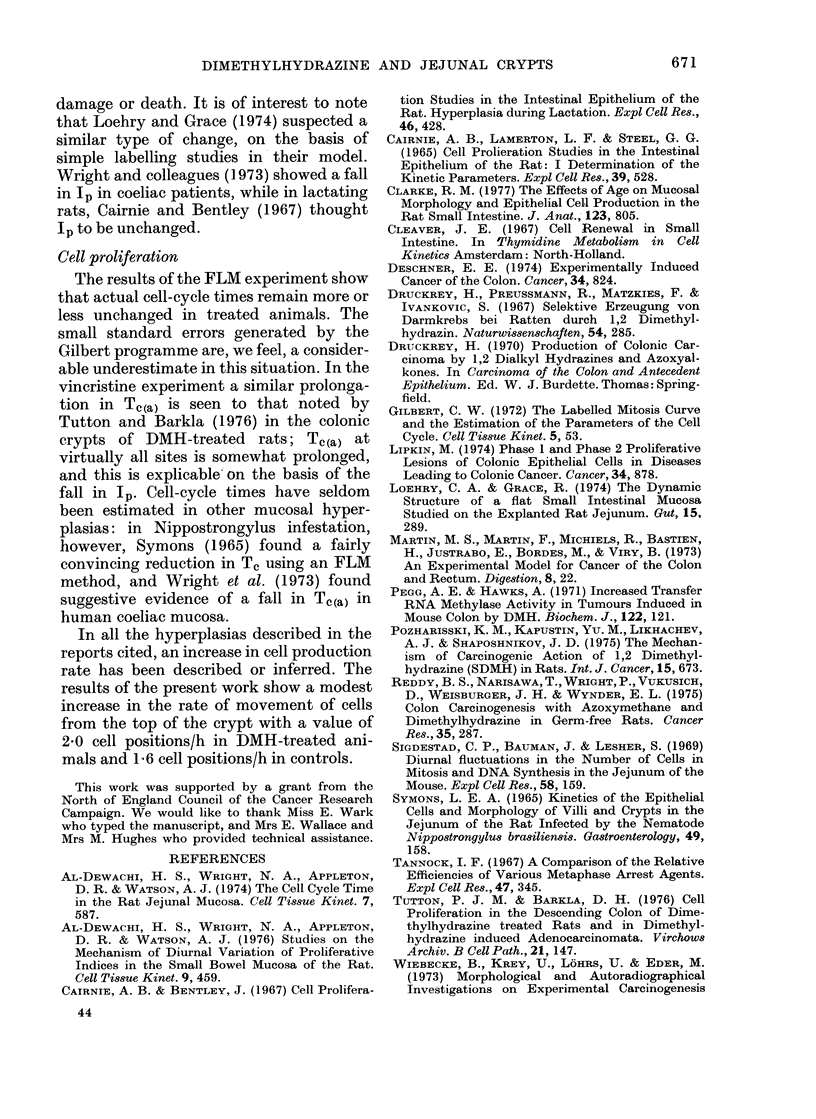

Images in this article
Selected References
These references are in PubMed. This may not be the complete list of references from this article.
- Al-Dewachi H. S., Wright N. A., Appleton D. R., Watson A. J. Studies on the mechanism of diurnal variation of proliferative indices in the small bowel mucosa of the rat. Cell Tissue Kinet. 1976 Sep;9(5):459–467. doi: 10.1111/j.1365-2184.1976.tb01296.x. [DOI] [PubMed] [Google Scholar]
- Al-Dewachi H. S., Wright N. A., Appleton D. R., Watson A. J. The cell cycle time in the rat jejunal mucosa. Cell Tissue Kinet. 1974 Nov;7(6):587–594. doi: 10.1111/j.1365-2184.1974.tb00442.x. [DOI] [PubMed] [Google Scholar]
- Cairnie A. B., Bentley R. E. Cell proliferation studies in the intestinal epithelium of the rat. Hyperplasia during lactation. Exp Cell Res. 1967 May;46(2):428–440. doi: 10.1016/0014-4827(67)90079-1. [DOI] [PubMed] [Google Scholar]
- Cairnie A. B., Lamerton L. F., Steel G. G. Cell proliferation studies in the intestinal epithelium of the rat. I. Determination of the kinetic parameters. Exp Cell Res. 1965 Sep;39(2):528–538. doi: 10.1016/0014-4827(65)90055-8. [DOI] [PubMed] [Google Scholar]
- Clarke R. M. The effects of age on mucosal morphology and epithelial cell production in rat small intestine. J Anat. 1977 Jul;123(Pt 3):805–811. [PMC free article] [PubMed] [Google Scholar]
- Druckrey H., Preussmann R., Matzkies F., Ivankovic S. Selektive Erzeugung von Darmkrebs bei Ratten durch 1,2-Dimethyl-hydrazin. Naturwissenschaften. 1967 Jun;54(11):285–286. doi: 10.1007/BF00620890. [DOI] [PubMed] [Google Scholar]
- Lipkin M. Phase 1 and phase 2 proliferative lesions of colonic epithelial cells in diseases leading to colonic cancer. Cancer. 1974 Sep;34(3):suppl–suppl:888. doi: 10.1002/1097-0142(197409)34:3+<878::aid-cncr2820340715>3.0.co;2-r. [DOI] [PubMed] [Google Scholar]
- Loehry C. A., Grace R. The dynamic structure of a flat small intestinal mucosa studied on the explanted rat jejunum. Gut. 1974 Apr;15(4):289–293. doi: 10.1136/gut.15.4.289. [DOI] [PMC free article] [PubMed] [Google Scholar]
- Martin M. S., Martin F., Michiels R., Bastien H., Justrabo E., Bordes M., Viry B. An experimental model for cancer of the colon and rectum. Intestinal carcinoma induced in the rat 1,2-dimethylhydrazine. Digestion. 1973;8(1):22–34. doi: 10.1159/000197298. [DOI] [PubMed] [Google Scholar]
- Pegg A. E., Hawks A. Increased transfer ribonucleic acid methylase activity in tumours induced in the mouse colon by the administration of 1,2-dimethylhydrazine. Biochem J. 1971 Mar;122(1):121–123. doi: 10.1042/bj1220121. [DOI] [PMC free article] [PubMed] [Google Scholar]
- Pozharisski K. M., Kapustin Y. M., Likhachev A. J., Shaposhnikov J. D. The mechanism of carcinogenic action of 1,2-dimethylhydrazine (SDMH) in rats. Int J Cancer. 1975 Apr 15;15(4):673–683. doi: 10.1002/ijc.2910150417. [DOI] [PubMed] [Google Scholar]
- Reddy B. S., Narisawa T., Wright P., Vukusich D., Weisburger J. H., Wynder E. L. Colon carcinogenesis with azoxymethane and dimethylhydrazine in germ-free rats. Cancer Res. 1975 Feb;35(2):287–290. [PubMed] [Google Scholar]
- SYMONS L. E. KINETICS OF THE EPITHELIAL CELLS, AND MORPHOLOGY OF VILLI AND CRYPTS IN THE JEJUNUM OF THE RAT INFECTED BY THE NEMATODE NIPPOSTRONGYLUS BRASILIENSIS. Gastroenterology. 1965 Aug;49:158–168. [PubMed] [Google Scholar]
- Sigdestad C. P., Bauman J., Lesher S. W. Diurnal fluctuations in the number of cells in mitosis and DNA synthesis in the jejunum of the mouse. Exp Cell Res. 1969 Nov;58(1):159–162. doi: 10.1016/0014-4827(69)90126-8. [DOI] [PubMed] [Google Scholar]
- Tutton P. J., Barkla D. H. Cell proliferation in the descending colon of dimethylhydrazine treated rats and in dimethylhydrazine induced adenocarcinomata. Virchows Arch B Cell Pathol. 1976 Aug 11;21(2):147–160. doi: 10.1007/BF02899151. [DOI] [PubMed] [Google Scholar]
- Wiebecke B., Löhrs U., Gimmy J., Eder M. Erzeugung von Darmtumoren bei Mäusen durch 1,2-Dimethylhydrazin. Z Gesamte Exp Med. 1969;149(3):277–278. [PubMed] [Google Scholar]
- Wright N. A. Variation in tritiated thymidine uptake during DNA synthesis in the adrenal cortex. Histochemie. 1971;28(2):99–102. doi: 10.1007/BF00279854. [DOI] [PubMed] [Google Scholar]
- Wright N., Morley A., Appleton D. Variation in the duration of mitosis in the crypts of Lieberkuhn of the rat; a cytokinetic study using vincristine. Cell Tissue Kinet. 1972 Jul;5(4):351–364. doi: 10.1111/j.1365-2184.1972.tb00374.x. [DOI] [PubMed] [Google Scholar]
- Wright N., Watson A., Morley A., Appleton D., Marks J. Cell kinetics in flat (avillous) mucosa of the human small intestine. Gut. 1973 Sep;14(9):701–710. doi: 10.1136/gut.14.9.701. [DOI] [PMC free article] [PubMed] [Google Scholar]



